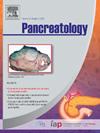Prediction of metastatic potential of heterogeneous pancreatic ductal adenocarcinoma through gradient-based algorithms
IF 2.7
2区 医学
Q2 GASTROENTEROLOGY & HEPATOLOGY
引用次数: 0
Abstract
Background
Pancreatic ductal adenocarcinoma carries a dismal prognosis, with five-year survival below 10 % due to late presentation, aggressive nature, and profound intratumor heterogeneity. Existing prognostic models fail to account for the dynamic interplay between subclonal evolution and the tumor microenvironment, limiting their clinical utility for risk stratification and therapy guidance.
Methods
An in silico, multiscale framework was developed, combining an agent-based model of subclone proliferation, migration, quiescence, and apoptosis with continuum reaction–diffusion equations for oxygen, nutrients, extracellular matrix, and chemoattractants. Four clinically relevant microenvironmental scenarios were simulated to generate spatiogenetic signatures of subclonal adaptation. These signatures were then sequentially input into three gradient-boosting classifiers—CatBoost, LightGBM, and XGBoost—to predict each subclone's metastatic potential.
Results
All hybrid pipelines demonstrated robust discrimination of high-risk subclones, with XGBoost achieving the highest sensitivity (92 %) and specificity (89 %) in cross-validation. The model accurately recapitulated PDAC's known clinical features, such as hypoxia-driven invasive fronts and desmoplastic stroma–associated resistance. Importantly, it uncovered novel biomarker signatures—combinations of genetic mutations and microenvironmental factors—that correlated with early metastatic seeding in simulated cohorts.
Conclusion
This work introduces a novel multiscale hybrid framework that is original both in its formulation integrating agent-based, continuum, and immune dynamics and in its application, where simulated biological signatures are used to train gradient boosting models for accurate prediction of metastatic potential.
通过基于梯度的算法预测异质性胰腺导管腺癌的转移潜力。
背景:胰腺导管腺癌预后不佳,由于出现较晚、侵袭性和肿瘤内异质性,5年生存率低于10%。现有的预后模型无法解释亚克隆进化与肿瘤微环境之间的动态相互作用,限制了它们在风险分层和治疗指导方面的临床应用。方法:建立了一个基于试剂的亚克隆增殖、迁移、静止和凋亡模型,结合了氧气、营养物质、细胞外基质和化学引诱剂的连续反应扩散方程,建立了一个多尺度的计算机框架。模拟了四种临床相关的微环境情景,以生成亚克隆适应的空间遗传学特征。然后将这些特征依次输入到三个梯度增强分类器中——catboost、LightGBM和xgboost——以预测每个亚克隆的转移潜力。结果:所有杂交管道对高风险亚克隆都有很强的区分能力,其中XGBoost在交叉验证中获得了最高的灵敏度(92%)和特异性(89%)。该模型准确地再现了PDAC已知的临床特征,如缺氧驱动的侵袭性前沿和纤维间质相关的抵抗。重要的是,它揭示了新的生物标志物特征-基因突变和微环境因素的组合-与模拟队列中的早期转移播种相关。结论:这项工作引入了一种新颖的多尺度混合框架,该框架在其配方中整合了基于药物的连续体和免疫动力学及其应用,其中模拟生物特征用于训练梯度增强模型以准确预测转移潜力。
本文章由计算机程序翻译,如有差异,请以英文原文为准。
求助全文
约1分钟内获得全文
求助全文
来源期刊

Pancreatology
医学-胃肠肝病学
CiteScore
7.20
自引率
5.60%
发文量
194
审稿时长
44 days
期刊介绍:
Pancreatology is the official journal of the International Association of Pancreatology (IAP), the European Pancreatic Club (EPC) and several national societies and study groups around the world. Dedicated to the understanding and treatment of exocrine as well as endocrine pancreatic disease, this multidisciplinary periodical publishes original basic, translational and clinical pancreatic research from a range of fields including gastroenterology, oncology, surgery, pharmacology, cellular and molecular biology as well as endocrinology, immunology and epidemiology. Readers can expect to gain new insights into pancreatic physiology and into the pathogenesis, diagnosis, therapeutic approaches and prognosis of pancreatic diseases. The journal features original articles, case reports, consensus guidelines and topical, cutting edge reviews, thus representing a source of valuable, novel information for clinical and basic researchers alike.
 求助内容:
求助内容: 应助结果提醒方式:
应助结果提醒方式:


